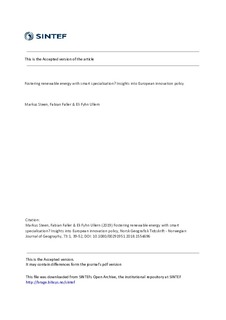| dc.contributor.author | Steen, Markus | |
| dc.contributor.author | Faller, Fabian | |
| dc.contributor.author | Ullern, Eli Fyhn | |
| dc.date.accessioned | 2019-03-06T12:09:55Z | |
| dc.date.available | 2019-03-06T12:09:55Z | |
| dc.date.created | 2019-01-21T09:18:10Z | |
| dc.date.issued | 2019 | |
| dc.identifier.citation | Norsk Geografisk Tidsskrift. 2019, 73 (1), 39-52. | nb_NO |
| dc.identifier.issn | 0029-1951 | |
| dc.identifier.uri | http://hdl.handle.net/11250/2588987 | |
| dc.description.abstract | The transition to a low-carbon economy is a major challenge confronting policymakers at all government levels. In the European Union (EU), ambitious targets for reductions in greenhouse gas emission are linked to aspirations of fostering green growth at national and regional levels. These aspirations have been manifested in a recent radical policy change through the introduction of the smart specialisation research and innovation strategy (RIS3) for national and regional development. The novelty of the RIS3 compared with previous EU innovation policy is that it aims to develop regional competitiveness based on the harnessing of regional assets rather than focusing on the provision of innovation infrastructure. In this article, the authors employ a mixed-methods research approach both to explore the nature and content of energyrelated priority settings in RIS3 strategies in the EU and to address the question of regions’ abilities to foster renewable energy through their place-based strategies. The article contributes to the literature on policy strategies for realising EU energy and emissions targets and the RIS3 aim of developing competitive advantages. The main conclusions are that energy-related priority settings vary substantially within RIS3, and that regional innovation policy ambitions may be hindered by unconducive policy frameworks at national levels. | nb_NO |
| dc.language.iso | eng | nb_NO |
| dc.title | Fostering renewable energy with smart specialisation? Insights into European innovation policy | nb_NO |
| dc.type | Journal article | nb_NO |
| dc.type | Peer reviewed | nb_NO |
| dc.description.version | acceptedVersion | nb_NO |
| dc.source.pagenumber | 39-52 | nb_NO |
| dc.source.volume | 73 | nb_NO |
| dc.source.journal | Norsk Geografisk Tidsskrift | nb_NO |
| dc.source.issue | 1 | nb_NO |
| dc.identifier.doi | 10.1080/00291951.2018.1554696 | |
| dc.identifier.cristin | 1661883 | |
| dc.relation.project | Norges forskningsråd: 209679 | nb_NO |
| dc.relation.project | Nordisk Energiforskning: 83130 | nb_NO |
| cristin.unitcode | 7401,90,30,0 | |
| cristin.unitname | Teknologiledelse | |
| cristin.ispublished | true | |
| cristin.fulltext | postprint | |
| cristin.qualitycode | 1 | |
